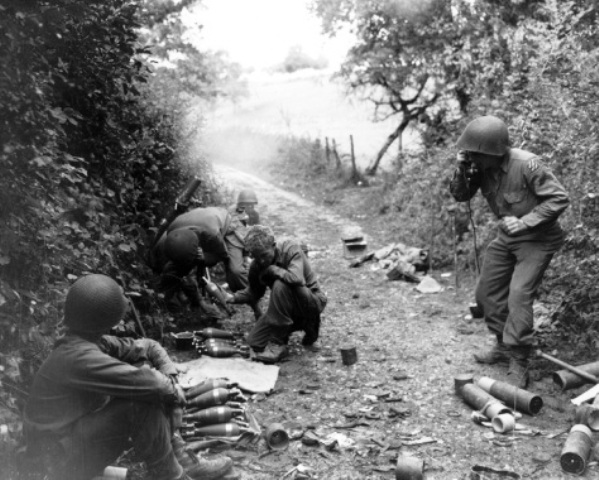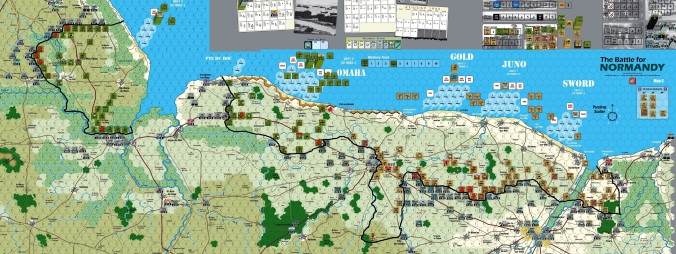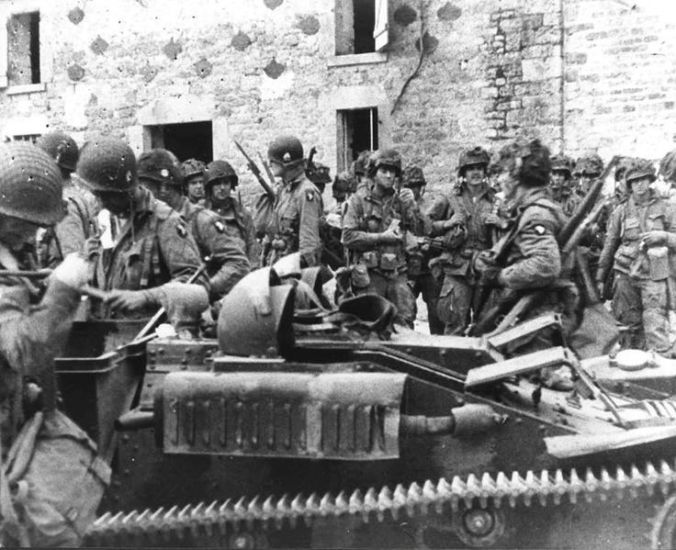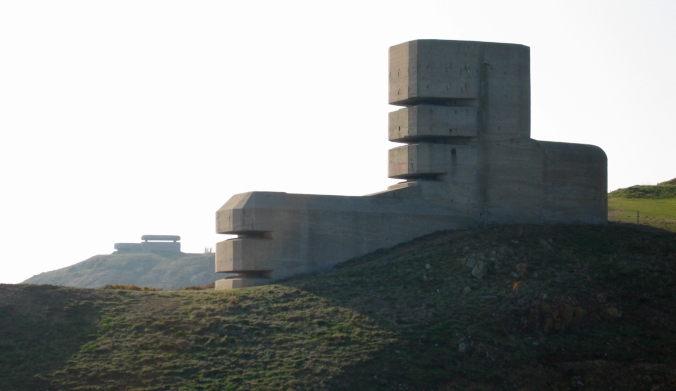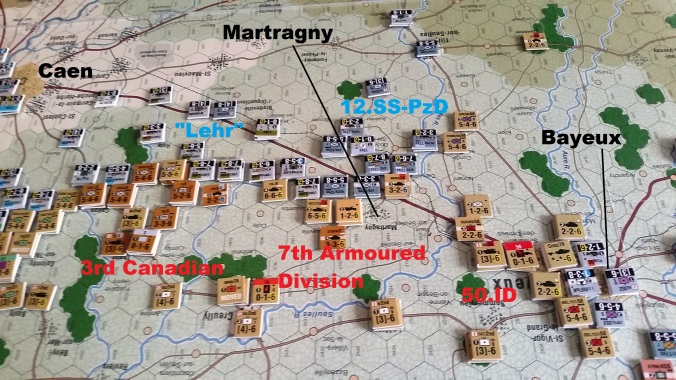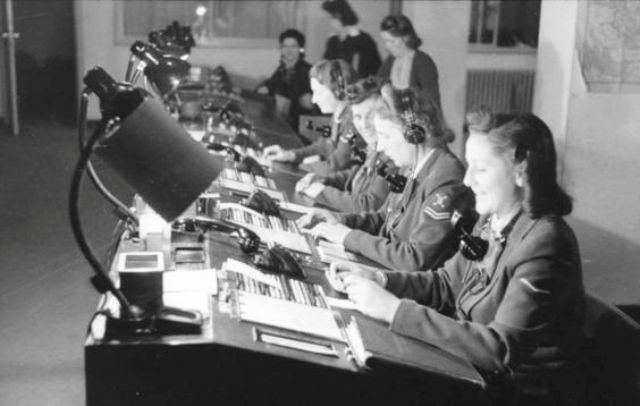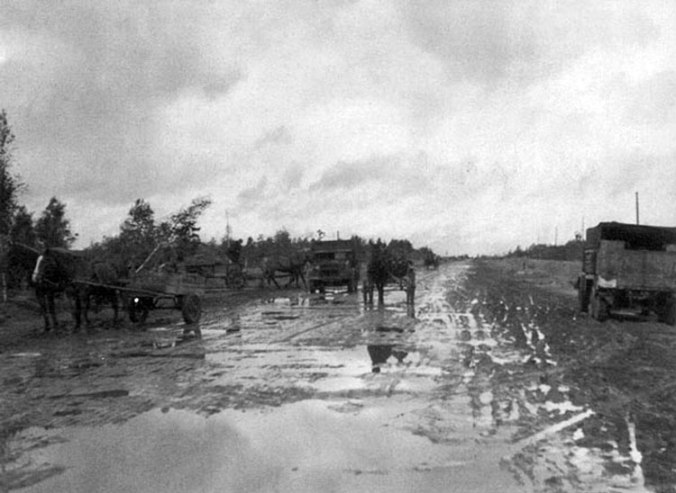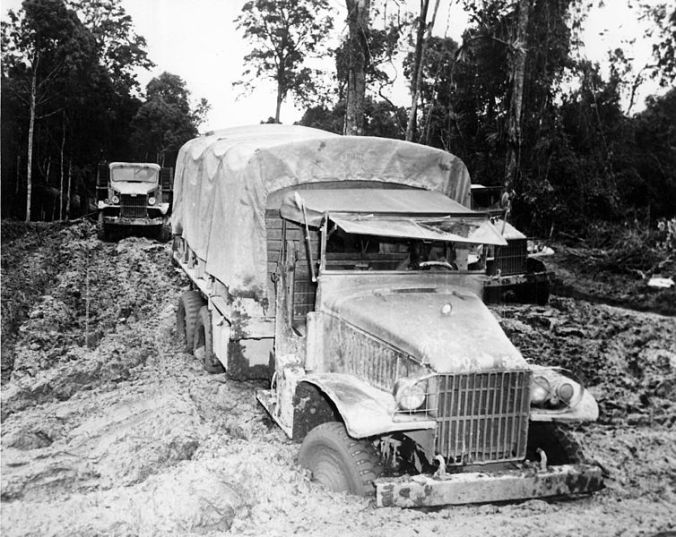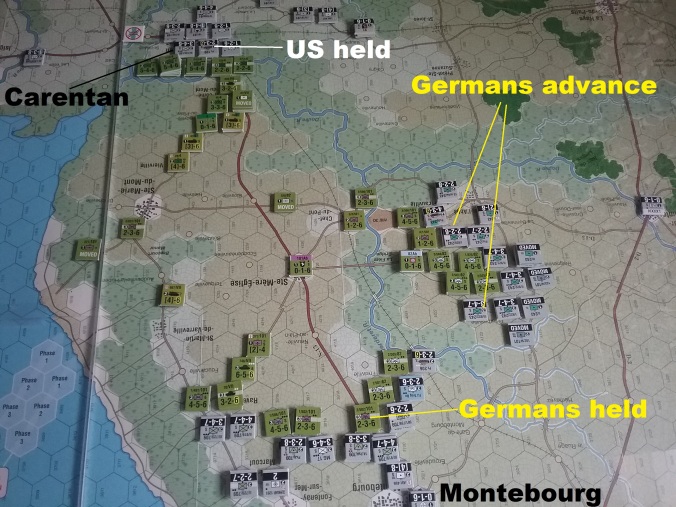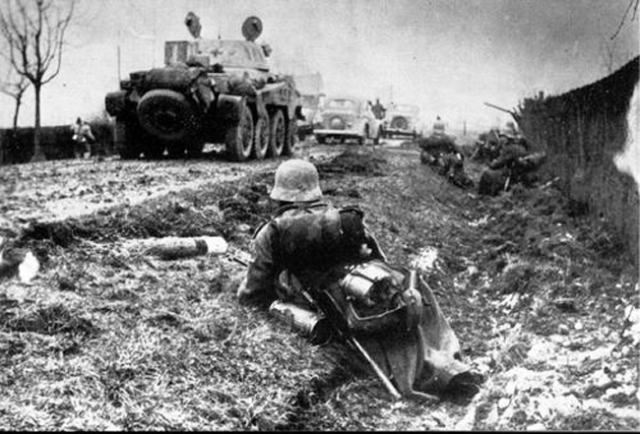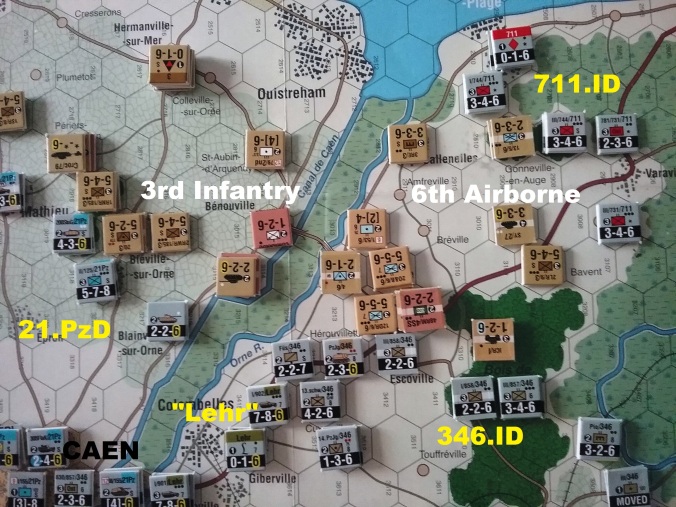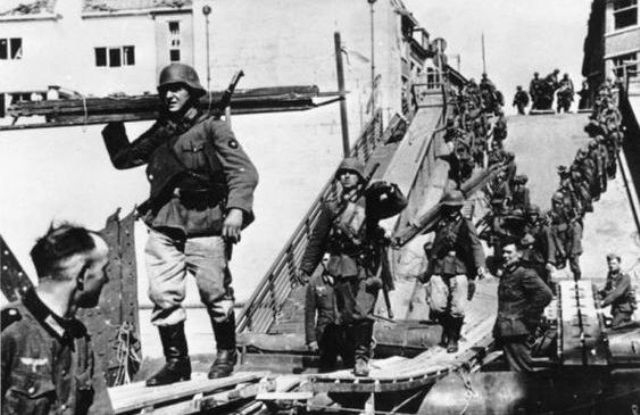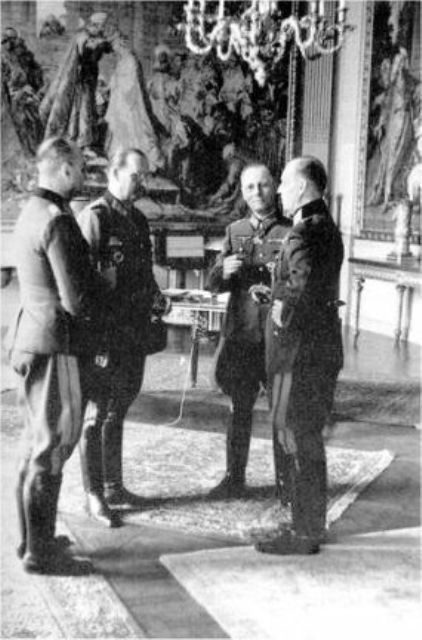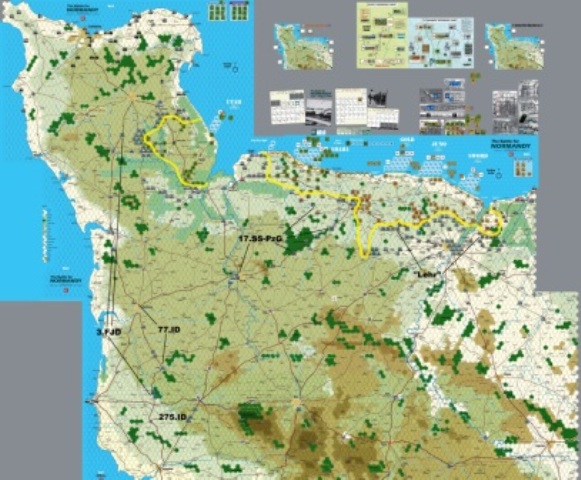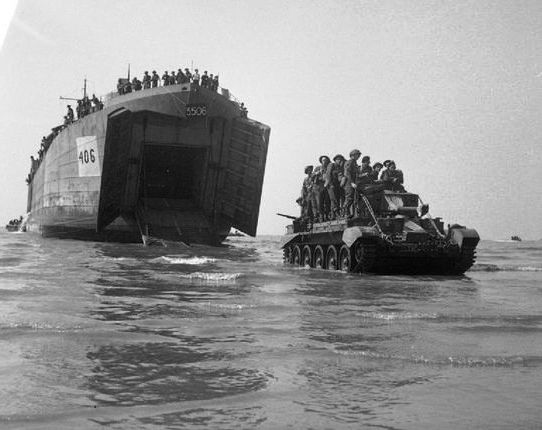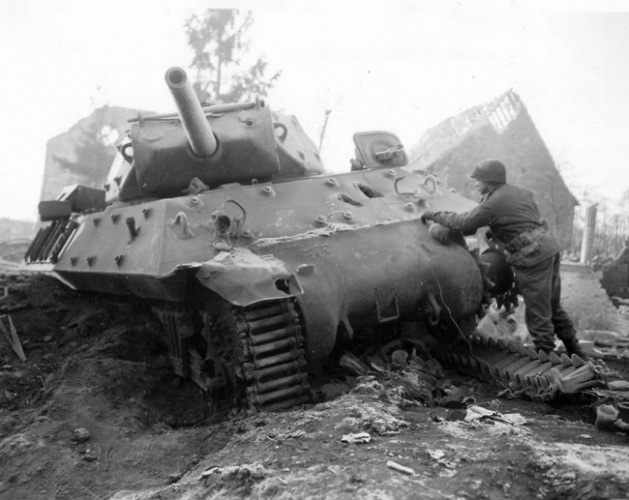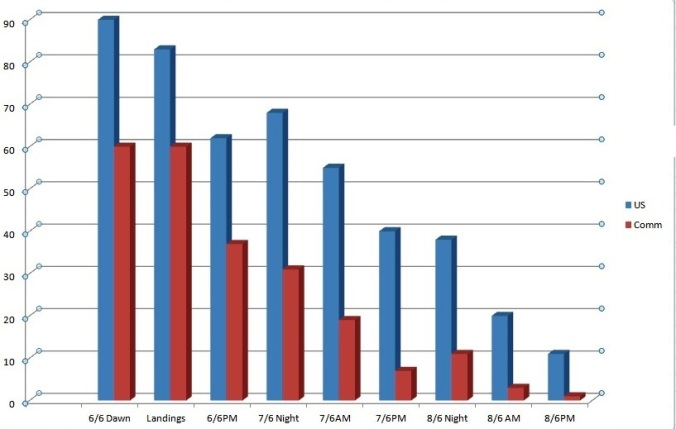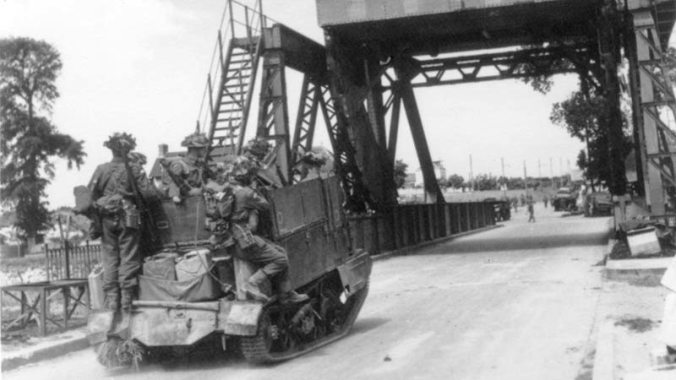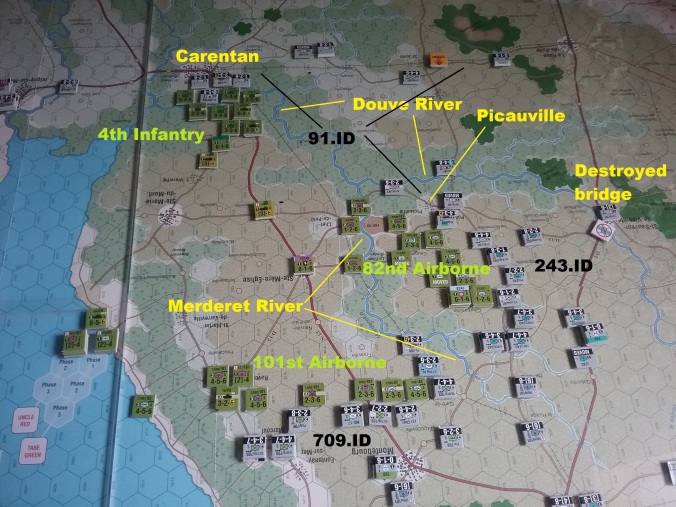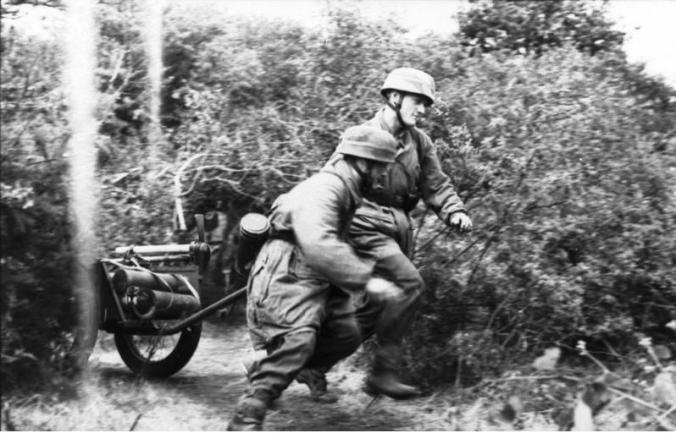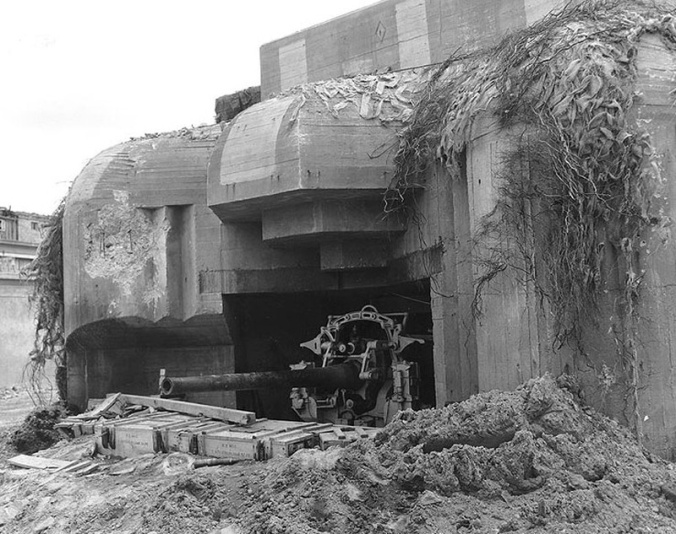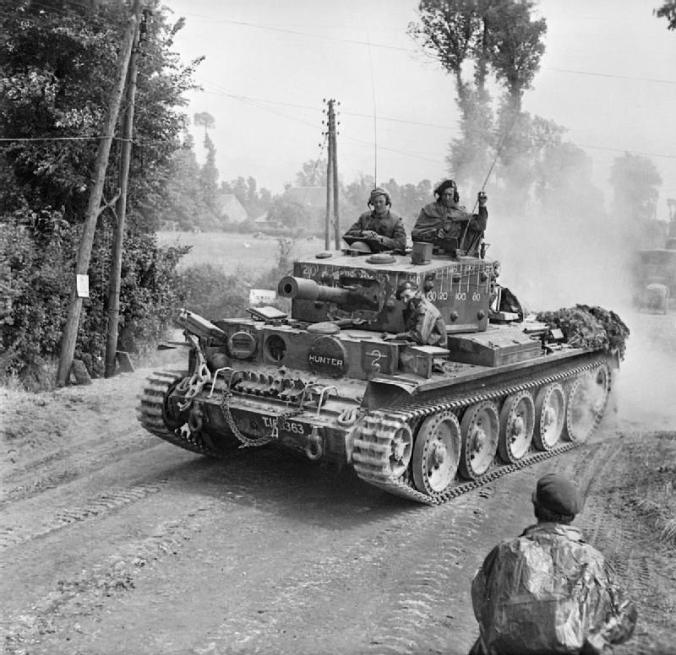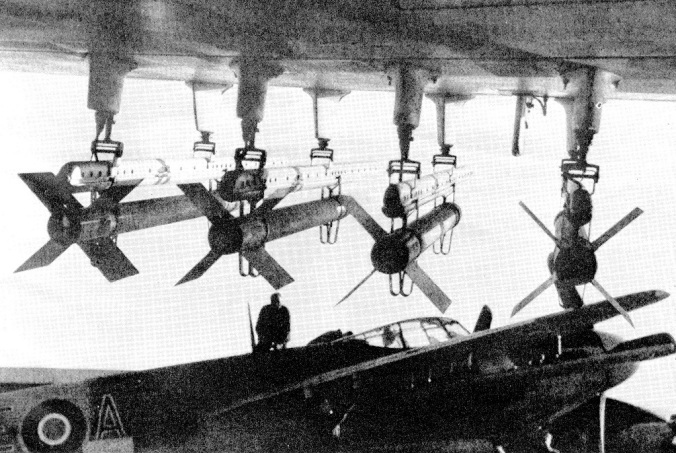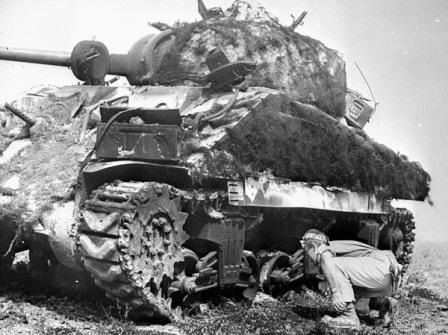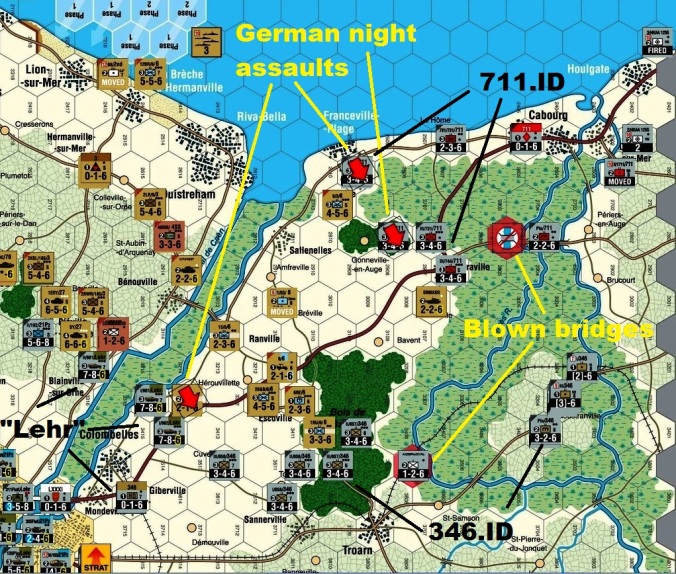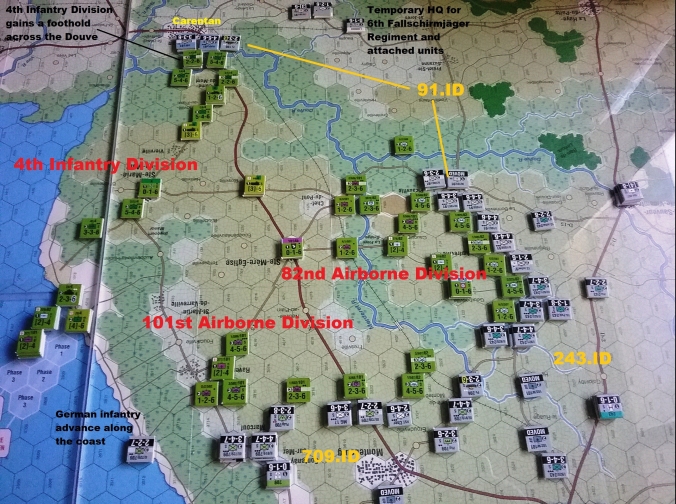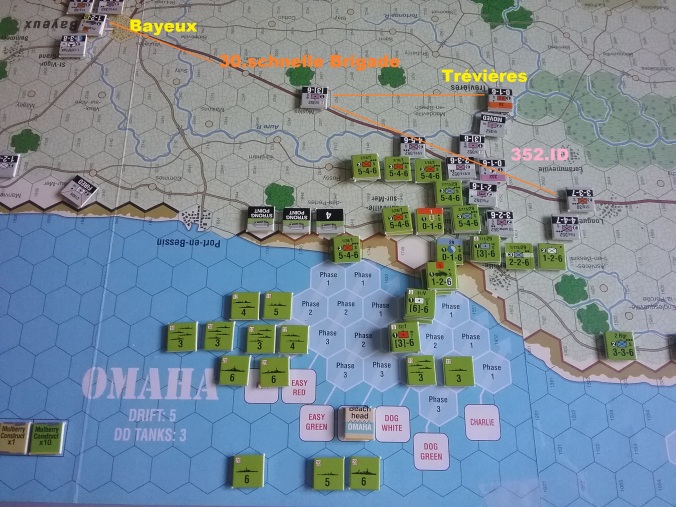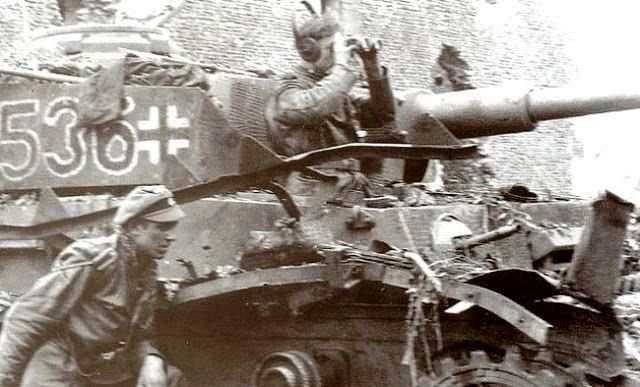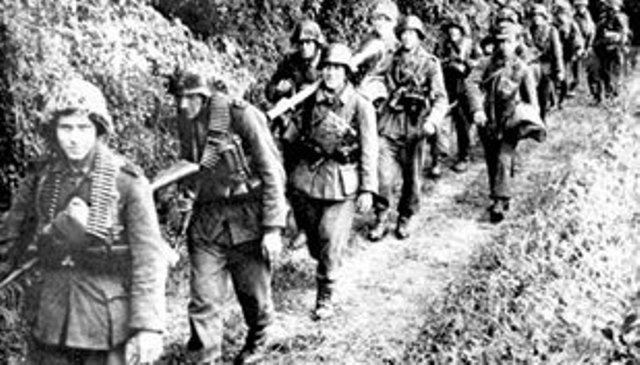From the diary of Major George Miller, US Army, attached to Supreme Headquarters Allied Expeditionary Force (with commentary)
7AM , Sunday 11th June (D+5)
Will this weather never end? This morning I woke and hoped I was dreaming as the all too familiar crashing of heavy rain on the tin roof broke into my consciousness. But no, it was real. Soaked by the time I struggled into Southwick House, the lack of cheery hellos eliminated any last hope that this was a local storm. A glance at the weather charts that were now prominent showed the predicted heavy rain had turned out to be another storm. The Channel would be closed until tomorrow. The storms should clear then, but the meteorologists could only promise a day or two of calm before another front moved in from the Atlantic. At least the word is that the two Mulberry harbours have not been damaged further – with some clear weather we can get the one at Omaha working in a week or so, though the one at Juno will take far longer.

Engineers risk their lives to work on a Mulberry during the storm
The other good news is that the commanders across the Channel have been busy. During the heavy fighting over the past days, many units have been destroyed. Although casualties were high, many men survived and much equipment could be salvaged. The corps commanders were still not ashore but divisional commanders took matters into their own hands and used these remnants to rebuild or strengthen units.
Overnight Ridgeway[1] rebuilt 1st Battalion, 325th Glider Infantry Regiment to full strength, though its commander[2] who had been wounded had to be replaced by Major Teddy Sanford. That was all that could be done on the Cotentin Peninsula but at Omaha Barton[3] reinforced 3rd Battalion, 22nd Infantry Regiment with stragglers rounded up from the beach. 1st Infantry did even better as Heubner[4] collected enough men to bring both 1st Battalion, 18th Regiment and 2nd Battalion, 16th Regiment back to complement. To top it all, 741st Tank Battalion[5], reduced to barely a company, was given enough Shermans and crews to reform its missing two companies. All told, not enough to break through to the east or the west, but enough to stiffen our defences.

Some tanks did not need a lot of work to get back into action
From what I heard, the British and Canadians were busy as well. A couple of armour battalions were supplemented and at least four companies of infantry were assembled and sent to battalions in need of men.
Otherwise, the situation remained dire. The exception was for the airborne divisions. On the peninsula, a weak battalion of 82nd Airborne[6] held off a large number of Germans, covering the escape of some Shermans[7] that looked as though they could have been trapped in the flooded areas near the Mederet River were pulled back. Some other airborne troops pulled back voluntarily, some in response to attacks. But no casualties were reported, not even from the enemy artillery which was completely ineffective. The British airborne were even less pressed, reporting a for once quiet night.
At the base of the peninsula, Barton[8] suffered a few hundred casualties from shelling, but nothing too serious. He did warn that unless the weather changed soon he would be forced to pull back as there seemed little point in keeping his men so close to the enemy when there was no hope of expanding his foothold south of the Douve. It was a similar story to the west. With his men blocked at La Cambe, Gerhardt[9] also asked if the steady losses to enemy artillery could be tolerated much longer.
It was around Bayeux that we suffered most. Our soldiers fought well, not yet showing the effects of the cold, wet and lack of support. An attack on Mosles[10] was forced back, but 1st Infantry lost another company in repelling what Huebner referred to as “a horde of SS infantry coming from all directions”. He went on to beg for ammunition for his guns: he has at least three artillery units ashore, but no shells.

A little preparation can make all the difference: defensive position in Mosles
The heaviest fighting was, without doubt, between Bayeux and Caen, just south of Camilly. The Canadians had a small force of engineers and a reconnaissance battalion placed between the village and the Thue River. Just after midnight they were hit by wave after wave of mechanised infantry and several tank units. As if that were not bad enough, a heavy artillery barrage was added. Resistance collapsed as they scrambled to escape. The engineer unit was wiped out, and barely a company of Staghounds made it to safety south of le Fresne Camilly. No significant enemy losses were reported.
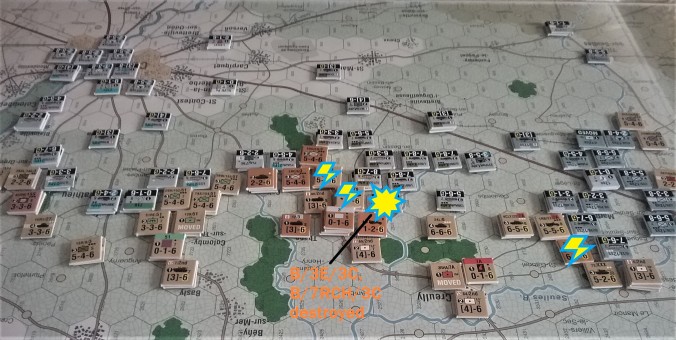
Caen to Bayeux: calm except for the unfortunate Canadians
The rest of the Commonwealth zone was comparatively peaceful with no attacks and little artillery fire. That was a relief. We can absorb these overnight losses without too many problems. The issue, however, is not the size of the losses, but lack of replacements. We grow weaker while the enemy grows stronger. For how much longer can our men hold firm against an enemy not restricted by a lack of supplies and reinforcements?
From the diary of Hauptmann Georg Müller, attached to Army Group B (with commentary)
7AM , Sunday 11th June (D+5)
Still the rain pours down. When I arrived at headquarters today I was assigned to an ad hoc group that had the task of finding out what roads were still in operation. We had to answer the constant queries from units trying to move north, providing information on road conditions ahead and advising of possible alternative routes. The good news was that we had a few more options: overnight our engineers had repaired the bridges at Subles[11] and across the Canal de Vire et Taute[12].

Not a huge obstacle, but without a bridge the Canal de Vire de Taute is impassable to vehicles
Rommel is apparently overjoyed that at last 2.PzDiv[13] has been released. It is no secret that he considers it essential that the British and the Americans do not link up. To make sure that does not happen, we must hold Bayeux. At the moment however, our grip appears tenuous. (As we have the responsibility for rerouting forces on the move, our group has access to the most up-to-date maps, clearly showing what areas are under our control). Our only secure communications links are the two roads to the southeast: the road to Tournières (north of the Forét de Cerisy) and the main road to St Lô (straight through the heart of the forest). There are bridges on both and we must prepare for the return of the enemy air-forces when the skies clear, as they will eventually.
Our orders this morning were clear: to keep 2.PzDiv moving north-east. Overnight it had passed through Argentan, but there was a long way to go. From what I could work out, it was intended that von Lüttwitz would insert his division behind Panzer “Lehr” and cover the main road from Caen. With some luck, it should be in place by noon tomorrow.
One commander has not waited for the reinforcements to reach him. Kraiß[14] has reformed an entire battalion[15] from the remnants of a dozen different units. Not only that, but his mechanics have been able to repair enough Marders to bring his self-propelled gun battalion back to full strength.
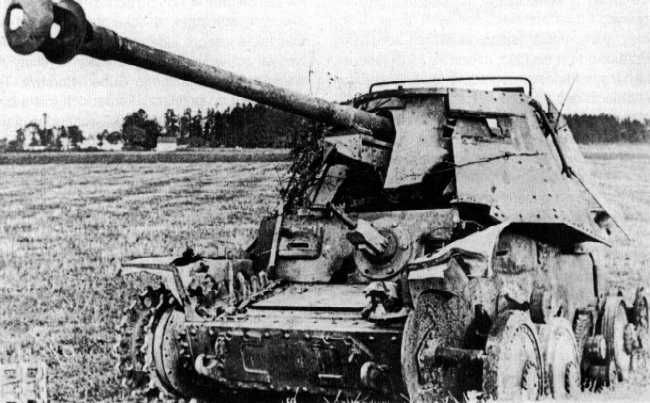
Some damaged Marders are beyond field repairs
There was little fighting overnight, though our artillery was active. An unsuccessful attempt to push east to Fresville[16] was all that von Schlieben[17] could manage, and while Hellmich[18] drove the enemy from Amfreville[19], his men were not able to move quickly enough to retake it.

Cotentin Peninsula: the airborne are proving hard to shift
Götz von Berlichingen[20] tried its best to push east to the Aure river crossing at Surrain, but even with two panzergrenadier regiments Ostendorff[21] could not break the American defence. Heavy losses were suffered on both sides. Our best result was east of Bayeux, where Lehr’s[22] tanks and infantry crushed the Canadians between the Thue and Mue Rivers and moved a little closer to the key town of Creully.

Bayeux sector: Götz von Berlingen cannot break the Americans
Not really enough to satisfy the demands from Berlin that the enemy be thrown back into the sea. But then those in Berlin are not fighting in the dark and the rain against a stubborn enemy with his back to the sea, knowing that every step back is a step closer to total defeat.
All we can do is keep up the pressure and hope more reinforcements can reach the front before the weather clears and the RAF and USAAF resume bombing.
Commentary
The Allies have been dealt a blow with another day of storms preventing supplies and fresh troops from landing in Europe. But they are not doomed. The bad weather has slowed enemy movement and made attacks more risky. While Allied losses are mounting, it will take some time at this rate to weaken them critically. More serious is that they are starting to retreat in key areas.
Even if the weather turns the invasion is far behind schedule and German strength is increasing ominously. Three division, one of them armoured, should reach the front by the end of the day, and that will give the German commanders localised numerical superiority.
Allied Losses (11th June Night)
1st Infantry: B/3/26/1
4th Infantry: A/2/8/4
29th Infantry: A/3/115/29
3rd Canadian B/7RCH/3, B/3E/3
German Losses (11th June Night)
17.SS-PzGD: A/II/38/17SS
Cumulative Losses
Allied Losses: Allied Casualties 11 – 6 Night
82nd Airborne: 3/505/82, 1/506/82, 3/507/82, 2/508/82, 2/507/82, 3/508 (4 Bn),
(10 + 15 PARA) C/1/505, A/2/505, A/2/235, A/1/507, A & B/1/325
101st Airborne: 2/501/101
(9 + 6 PARA) B & C/1/501, H & I/3/501, H & I/3/506, A/1/502, D/2/506, 2 x D/2/502, E/2/501, A/326E
1st Inf Div: 2/16/1
(6 + 3 INF) A &B /2/18/1, B/3/16/1, A&B/3/26/1, A/1/18/1
4th Inf Div: 1/8/4
(3 + 8 INF) A/3/8, A/3/12, A/1/12, A/1/22, A/2/12, 2 x A/2/8, A/3/24,
29th Inf Div: 1/116/29, 1/115/29
(8 + 8 INF) A(x2) & B/3/116/29, A /2/116/29, 4 x A/3/115, A/1/175, A/2/175
5th Rangers: A & B/5
2 COMM
Independent 743/V, 741/V
10 x ARM A/70/VII (DD), A & B/745/V, A/899/VII
6th Airborne: 7/3/6, 8/3/6, 1st Canadian/3/6, 12/5/6, 1RU/6/6
(9 + 12 PARA+ D/2nd O & B/5, AARR/6 (1 ARM), A/13/5,
1 x ARM, 2 x AT) A/4 (AT), A & B/12DR/6, A/9/3/6, A/2O&BLI/6, A/3 (AT)
3rd Inf Div: 1SL/8/3
(4 + 7 INF + 1 ARM) A & C/2EY/8/3, B/2EY/8/3, A/1RNR/185/3, A/3/3 Recon, A/1KOSB/9/3, A/1CS/7/3, A/2RUR/9, A/2KSL/185
7th Armoured: 8KRH (2Bns)
(2 INF + 2 ARM) A/1RB/22/7A, B/IRB/22
50th Inf Div: 2 x A & B/1HR/231, A/6GH/231, A & C/5EY/69
(6 + 4 INF + 1 ARM)A & B/7GH/69, A/6GH/69, A/6DL/50, A/61/50
3rd Canadian: RRR/7, RW/7, QOR/8 (4Bns),
(5 + 11 INF, 2ARM) C/NS/8/3, 2 x A/NNSH/9/3, A&B/7RCH, A&B/3E/3, B/7RCH/3
4th Special Service Brigade: A/47RM, A/48RM, C/41RM, A/46RM
4 COMM
1st Special Service Brigade: A & B/4RM, B & C/3RM
(2 +2 COMM)
Independent A/NY/8 (DD), A/4/7/8 (DD), A/27SFR/2, A &B/1ERY/27
14 ARM, 1 INF 1&3 RMASG, C/13/18/27, A/1CR/1 (Recon), B/5/7/8, A&B/6H/2, A/73/XXX, A/13/18/27, A/12KR/8
Air Losses:
Combat Support 2
Armed Reconnaissance 1
German losses: German Casualties 11 – 6 Night
12.SS-PzD: 15.Aufk/12.SS-PzD
6 INF, 2 ARM A/PzPio, A/I/25, 2 x A/II/25, 2 x A/1/26
17.SS-PzGD: A/15.Aufk./17SS, A/II/38/17SS
1INF, 1ARM
21.PzD: II/192/21.PzD, 1/192/21.PzD, 9siG/21.PzD (2Bns)
8 INF, 3 ARM A/II/121/21Pz, A/200 PzJag/21.PzD, A/I/125/21.PzD
30.schnelle Brigade: 513/30, 51/30
7 INF A/518/30
91.ID: 191/Pio/91, 14.PaK/91, 13/6FJ/9(1Bn), 111/1058/91(4Bns), I/III/6FJ
15 INF, 2 AT A/1/919/91, A/13.schw/91, A/II/1057/91, A/I/6FJ, B/II/6FJ, B/I/6FJ
130.PzD “Lehr” 10.SiG/130, A/II/901, A/130.Auf
1 INF, 2 ARM
243.ID A/1/920, A/1/922 A/II/922,
3 INF
346.ID: A/Füsilier/346, A/III/858/346. A/I/858/346
3 INF
352.ID: 14.PaK/352, Pio/352 (3Bns), 13.schw/352 (4Bns)
15 INF, 2 AT B & C/II/916/352, 2 x A&B/II/914,
2 ARM A & B/Füs, A/II/915/352, A/PzJag, A/I/916
709.ID: B & C/1/919, A/795/739, A/III/739, A/II/729, A/I/6FJ, A/561/739/709
7 INF
716.ID: II/726/716, I/736/716, 642/736/716 Ost, 14.PaK/716, PzJag/716, 439/726/716 Ost, II/736/716, 441/716/Ost, III/726/716, 1/736/716 I/726/716,
27 INF, 4 AT A &B/III/735/716, A/Pio
Independent: II.1/III Flak, A/I.1/III Flak
3 Flak
Independent: Abt 989
1 Art
Strongpoints: 10 x (4), 11 x (3), 6 x (2), 5 x (1)
32
Static Artillery: 1/AR 1716, 2/AR 1716, 3/AR 1716, 7/AR 1716, 1/HKAR 13 1261, 6/ AR 191, 2/HKAA, 6/AR 1716, 2/HKAR 1251, 5/AR 1716, 3/HKAA 1250, 10/AR 1716, 4/HKAA 1260
Notes:
[1] Major General Matthew Ridgway, 82nd Airborne Division
[2] Lt. Colonel Richard K (“Klemm”) Boyd, wounded in action 7th June 1944. In addition, the commander of “C” company, Captain Dave Stockley, was wounded and captured on 9th June and was replaced by Captain Wayne Pierce.

Captain Wayne Pierce assumed command of C Company after the loss of Captain Stockley
[3] Major General Raymond Barton, 4th Infantry Division
[4] Major General Clarence Heubner
[5] Led by Lt Colonel Robert Skaggs
[6] 2/505/82
[7] “A” Company, 746th Tank Battalion
[8] Major General Raymond Barton, 4th Infantry
[9] Major General Charles Gerhardt, 29th Infantry
[10] A small village on the Bayeux – Isigny main road, about halfway from the landing beaches to Bayeux.

Mosles today – quiet, almost sleepy. But on 11th June 1944, the scene of bloody street fighting
[11] Subles: a small village south-east of Bayeux on the Drôme River, on the main road St Lô – Bayeux
[12] The bridge is on the road from St Lô heading north to Cherbourg.
[13] 2nd Panzer Division had been in France since late 1943, refitting after suffering heavy losses in Russia. It had been equipped with Pzkpfw V “Panther” tanks. Its commander, Diepold Georg Heinrich Freiherr von Lüttwitz, Baron von Lüttwitz, had only taken command on 27th May.
[14] Generalleutnant Dietrich Kraiß, commander of 352.ID
[15] II/914/352
[16] Midway between Montebourg and St Mère Église
[17] Generalleutnant Karl von Schlieben, 709.ID
[18] Generalleutnant Heinz Hellmich, 243.ID
[19] West of St Mère Église, across the River Mederet
[20] 17.SS-Panzergrenadier-Division
[21] SS-Gruppenführer Werner Ostendorff
[22] 130.Panzer-Lehr-Division

